Guest post by Prof Vinesh Thiruchelvam, Dr Siti Azreena, Asia Pacific University of Technology and Innovation.
VR platforms allows users to experience a realistic environment with visual, auditory and sometimes haptic stimuli. By manipulating the virtual objects to perform tasks the users get an immersive experience engaging multiple senses. The integration of haptic feedback, auditory stimuli and even olfactory elements has broadened the scope of VR applications across various fields, with a particular emphasis on education. In the realm of education, VR transcends traditional pedagogical approaches by offering immersive, experiental learning. Virtual field trips, historical reenactments, and scientific simulations provide students with engaging and realistic educational experiences. Studies indicate that VR-based learning experience enhances knowledge retention and engagement, making it a valuable tool for educators. One of the best example of VR-based learning experiences in education is VR laboratories.
Collaboration between Asia Pacific University of Technology & Innovation (APU) and International Medical University (IMU) in Malaysia stimulated the development of VR-based microbiology laboratory on Head-Mounted Display (HMD) for undergraduate students. Student and faculty perceptions and expectations were collected to incorporate into the design of the virtual laboratory. An interactive 3-dimensional VR laboratory with a 360° view was developed simulating the physical laboratory setup.
In this VR laboratory, six microbiology experiments on Gram staining, bacterial streaking, bacterial motility, biochemical tests, catalase test and oxidase test were placed on the virtual platform. First year biomedical science students were recruited for evaluating the VR laboratory. Students' perception of the virtual laboratory was positive and encouraging. About 70% of the students expressed they felt safe using the VR laboratory and positively claimed that it is able to provide an immersive learning experience. The students appreciated that they could repeat each experiment multiple times without worrying about mistakes or mishaps and could personalise their learning by concentrating on the specific experiments. Although this laboratory was developed for biomedical science students, this is extended to students of other health professions like medicine, pharmacy, biotechnology etc. In future, the laboratory can be further enhanced to include visualisation of enhanced microbial features, different infection scenarios and biosafety level three microbes to make it more interesting and meaningful. Future research may focus on refining the instructional design principles, integrating artificial intelligence for adaptive learning experiences, and exploring the effectiveness of VR labs in different educational contexts.



